#rpg safety tools
Text
DnD safety tools quick and dirty pro tip:
The two extremely common triggers that people almost never think to put on their "lines and veils" sheet and then end up having an unpleasant experience with, are drug overdoses and suicide.
Everybody thinks to say "no rape" or "no torture" or "no slavery" but huge amounts of people have trauma with drug overdoses and suicide (two of the leading causes of traumatic death) that they don't think about during session 0. I strongly recommend that you ask your players straight up before you include those two elements in your game. Even if you're playing a high fantasy campaign, it is common to have fantasy drugs/substances that can be poisonous in large doses, or ritual/henchperson suicide.
Literally even if you did an RPG consent checklist that asked about those two things, if it's been a while since the start of your campaign, ask again. We once had a player lose a friend to suicide in the middle of a two-year campaign. Life comes at you fast.
I have played Dungeons and Dragons for nearly ten years, with an extremely conscientious dungeon master who has been using safety tools since before they were cool. The only player triggers that still consistently come out of nowhere and bite us in the ass are these two. Spare yourself the headache and ask your players if you're considering one of these storylines.
9 notes
·
View notes
Text
The X card isn't actually a good system of setting boundaries in an rpg context. It attempts to speed up and get away when someone is triggered when that's a very bad way of dealing with things, and attempts to disallow all discussion when you have to talk to properly set boundaries.
I've ran and played in games with strangers for years and the only time its ever been used has been as a method of bullying people. Because the X card is the exact type of thing people who see other's kindness as a way to seek power will utalize.
I think the X card is popular with game designers because it uses the language of game design. But boundaries are the one thing that can never be a game mechanic.
9 notes
·
View notes
Text
Wanna make running online TTRPGs easier?
Great news! I made a prep template for Monsterhearts 2, but it's very adaptable for other Powered by the Apocalypse games (or honestly, your favourite TTRPG).
This template establishes what players can expect from your game, lets you do your safety setup (like lines and veils), and has a who's who for your Player Characters & NPCs all in one single document!
This document is: Neurodivergent friendly | Colour-coded | Highly customizable | Google Docs shareable
What's inside?
Player instructions for what to do before the game
Details about the structure of your game
The Safety section - including a brand new safety tool I designed!
Charts for your PCs and NPCs
Setting Lore Activity
Custom Moves (Two of them! I wrote these for you)
Check it out: https://orbw.itch.io/monsterhearts-prep
8 notes
·
View notes
Text
CATS or What Is This RPG or Setting The Table
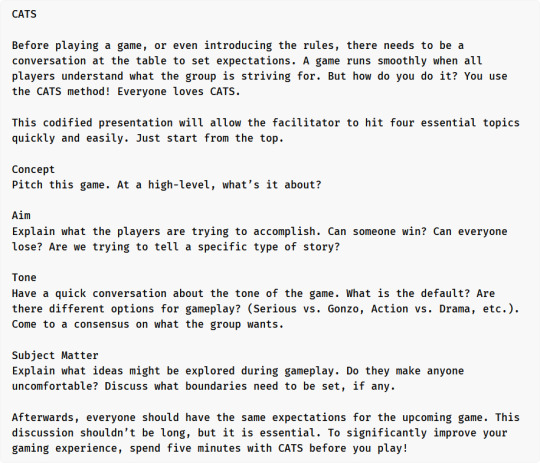
So I just heard about CATS courtesy of the good folks in the PlusOneExp discord server. CATS was written by Patrick O'Leary for the 2016 200 Word RPG Challenge.
It's nice and short (200 words even) and it's a compelling formula for the classic What Is This TTRPG segment that warrants a page at the front of every good RPG book.
I find it particularly interesting that this is imagined as a micro-RPG in its own right, a table activity for the start of game night that sets out to address what I have always found to be the most painful aspect of playing any TTRPG (besides tedious and arcane character creation rituals – I'm looking at you 5e PHB 👀): the friction that arises from players having discordant, conflicting, contradictory or incompatible expectations during play.
We can formulate the basic strucure of CATS in a variety of ways: Concept/Aim/Tone/Subject Matter, What/Where/When/Who/Why/How, Premise/Overview/Goals/What You Need, etc. all of which can be applied in two immediate directions:
In a What Is This RPG section, these are just codified methods for teaching the player/reader (more of my thoughts on the player/reader here) how to read and communicate everything that comes next in a way that's both more focused than a blurb (which might basically constitute the Concept/Premise/Hook) and more comprehensive than an elevator pitch.
As a launchpad for table play, these structures guide the conversation to establish the pillars of the shared fiction, and I especially appreciate CATS for the fact that it ends on Subject Matter. It could be the consequence of a tortured acronym, but having set the stage in every other way it seems appropriate to hop into safety tools as the final as the final negotiation before play, once all context is provided but nothing is yet set in stone.
That's all he wrote on CATS.
In THE PERILOUS PEAR & PLUM PIES OF PUDWICK I wrote a conversation guide to the meat of the adventure on pg. 11, following an introductory segment of the game that functions as a session 1 prologue of sorts before delving into the hexflower "dungeon" microsetting, inciting incident et al. It's interesting for me to look back at the way I structured this from the perspective of CATS.
If you're curious about TPPAPPOP and want a sneak peak of what you can expect, here's that segment from pg. 11, Inside The Tree:
Resources: the insects of the tree live in darkness and have varying weird diets – you might decide that tracking resources like light and food is important, or maybe at this scale adventurers can survive on the honeydew, leaves and strange meats that the insects eat.
Sights and Sounds: footsteps might sound like earthquakes, voices like distant thunder. What are the twitches and mannerisms of the chittering language of insects? How does artificial light disturb the denizens of the tree?
Setting and Tone: to adjust the game to your group's preference, you might lean into the existential conflict of intruding on and potentially dooming these fledgling societies, or downplay the crawling horror of an insect world to allow its cuter side to shine through.
#TPPAPPOP#TTRPG#indie TTRPG#indie tabletop#tabletop#ttrpg design#bugs bugs bugs#d&d#CATS#5e#tabletop design#indie dev#TTRPG dev
242 notes
·
View notes
Text
RPG Read-through: .dungeon//remastered
For a while on Twitter, I've been doing read-through threads where I post my thoughts as I'm reading through a game for the first time. I recently did the same with Snow's .dungeon//remastered, a TTRPG where you are players logging in to a dead/dying MMO and exploring the digital fantasy world. I'm adapting those thoughts here for a proper Tumblr post! Enjoy!

First up, credits! Good folks who do good work in my experience. Also, we get the first of what seems to be a common through-line here that I enjoy: an online fandom bent to this all being a sort of GameFAQ style guide for an in-universe game.
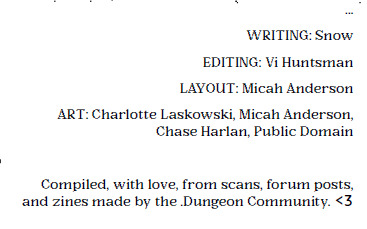
My initial impression from most of the interior spreads I've seen just flipping through it is that I really love the style and layout. I think black and white layouts are underrated generally, but it really pops here with the pixelated text/symbols and the old school GUIs.
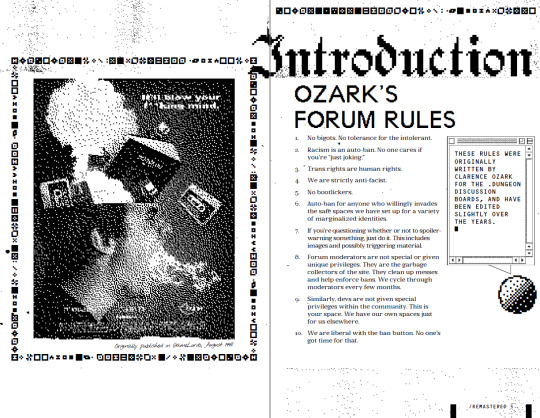
It's interesting to have these kind of "no bigotry" rules you see in many games couched within an in-universe framing. I think this more personal angle actually makes them land better for me than they typically do in games.
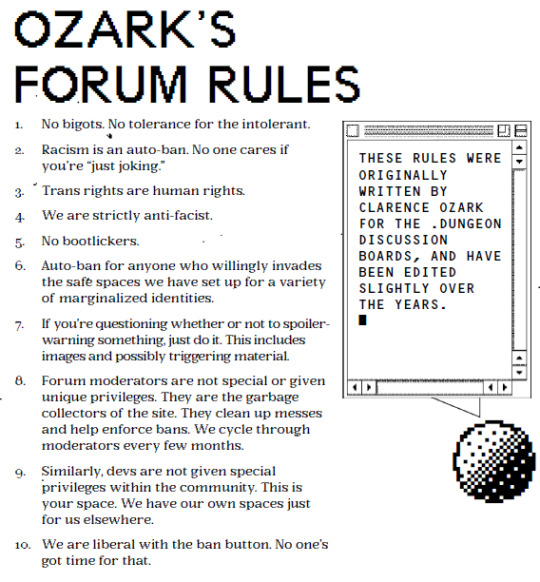
Of course, the author is still powerless to stop the players (just like with any instance of these rules, and all game rules in general tbh) BUT this is worldbuilding too, and it gives me a greater sense for the kind of in-universe fandom that's risen up around .dungeon.
Similarly, here's the game's unique version of safety tools - an in-game help menu that reworks things like lines/veils, x-card and more into the game world itself. I really like this.
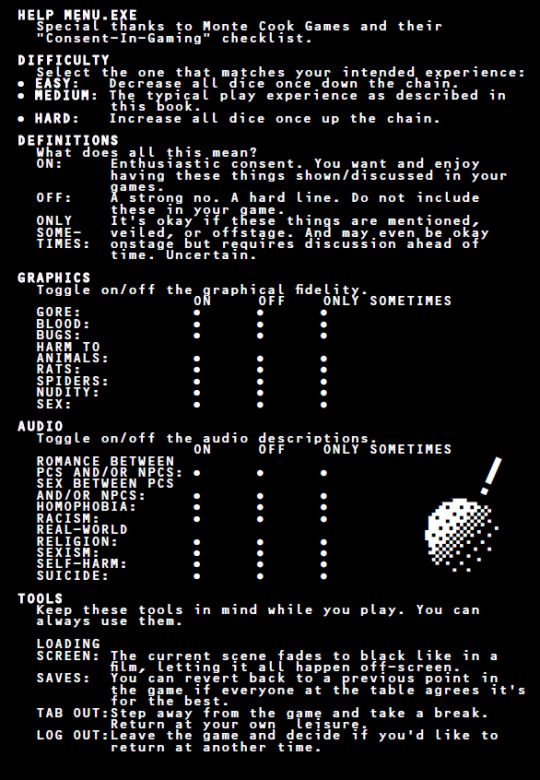
Once again, the art in this is just great. I love the Fez-like runes/symbols. My ARG brain wants to know if there's a hidden message here.

I was surprised it was jumping right into the starter adventure, Tutorial Town, but I quickly found out that this is character creation AND a starting area/adventure all wrapped into one, video game-style, and that's so cool.
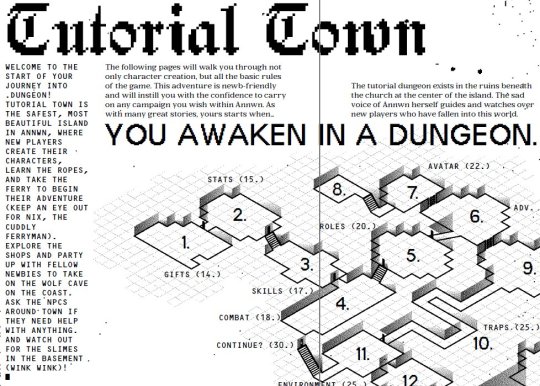
Each room of the starting area introduces a step of character creation. It's interesting that stats are based on real-world (not you the player at the table real-world but your PC at the "real-world" computer playing the game) ability. Your game knowledge, response time, etc.

As a long time Dota player, I also just really enjoy that the saving throw-like stat here is TILT. I have tilted many times and known many of my teammates to tilt regularly. Just fun to see that phrasing in a TTRPG.
There's more of the in-universe real-world player here than I expected coming in. Definitely has some really intriguing potential. I do wonder though if the intent is to be playing a "real-world" level character or if you are "playing" as yourself at that layer. Both would work.

Monster statblocks. Easy to parse and straightforward to run as the GM (tho at time the layout does have one two many things laid on top of one another that can make them hard to read at first glance - like where "GOBLIN" is here):

Health here is SYNC, and it's shared across the whole party - I'm interested to see how that full mechanic plays out and how it may affect play.

Reaction rolls. I'm surprised to see them given the video game setting, cus mobs in MMOs just always attack you. I've gone back and forth on it with my video game-inspired TTRPG. Don't think it's a bad choice, just one that means the game world is more than a usual video game.
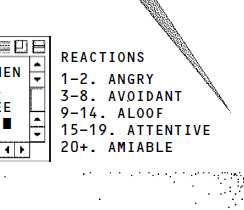
So you have your real-world level Job (based on your characters' out of game job) and your in-game "Role" which follow the classic "holy trinity" of MMO design:
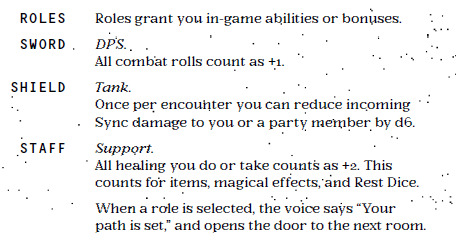
PCs and monsters can team up to attack and can forego damage for stunts - potentially fun/interesting moments happening from that. Monsters deal dmg to SYNC but only per type is interesting, means a crowd of one-enemy is more a long trickle of damage than an overwhelming burst.
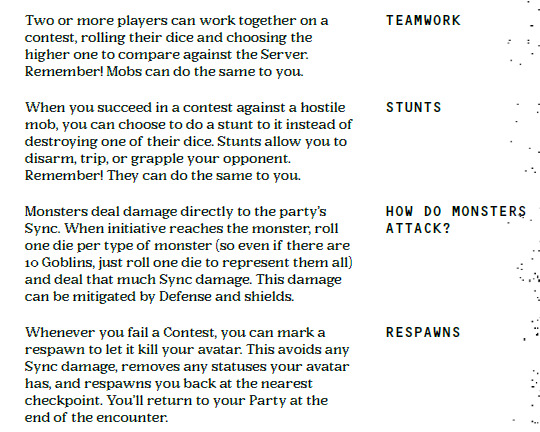
Not knowing the ramifications of SYNC damage yet, I'm not sure what the Risk v Reward looks like for Respawns but it's intriguing. Letting your avatar die to keep the party in a stronger position overall (but being able to re-join after a fight) is definitely unique.
This is another fun room (and I like that other than saying late 90s/early 2000s it leaves appearance options open). I am not sure where to find the starting origins tho (they aren't on this spread and there's no page reference). Sadly, the PDF isn't bookmarked either, it seems.
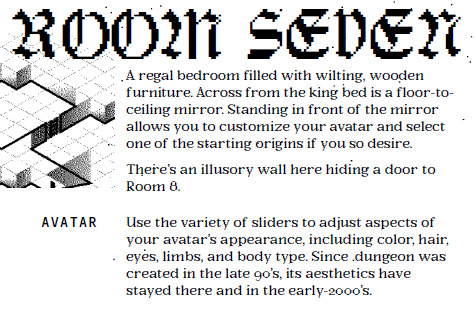
This feels like a smart roadblock to place in player's paths early on. It's unlikely they'll have a lockpick at this point so really, it's about getting players into that creative mindset. What is in the room for you to exploit? What gear do you have you can use in a new way?
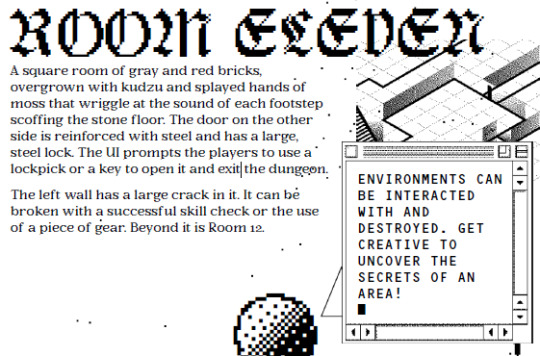
Might seem basic, especially to the OSR-experienced out there, but you'd be surprised how many players don't have experience with thinking more freeformly about the game in this way. No fault to them, most trad games condition you to use your PC's abilities/skills as a menu.
Another cool interaction between the layers of the game here (tho I do wish they all played more off of something more than just the tarot card being in the real-world layer). Still wondering if most folks play as themselves or as a real-world level PC.
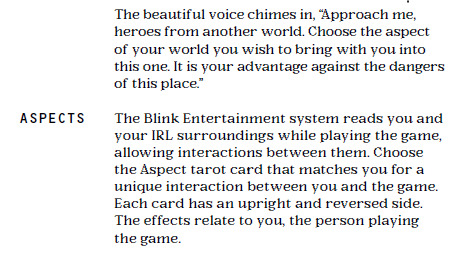
This is interesting. I wonder if there is going to be a real-world layer to play or if this is meant to be the amount your party can heal between sessions of play (like when the actual real you stops playing in actual real life - this meta layer stuff is tricky to communicate).

I like this - a very short and sweet travel system.
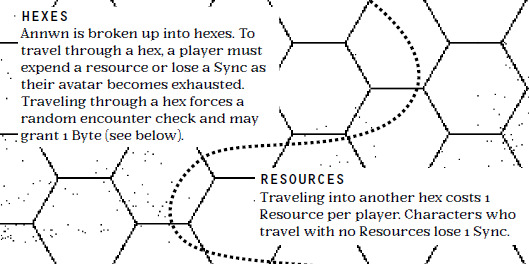
I continue to love this art. Also, this tease here around dual-wielding requiring the discovery of new Roles out in the game world somewhere first is really enticing (I added the highlighter there btw).
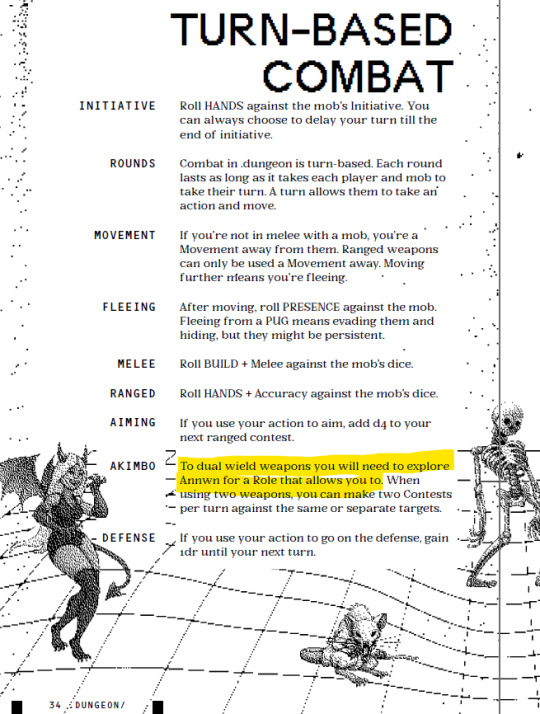
This is fun - there are both in-game NPCs and PUGs which are other real-world players' in-game avatars. That extra layer to those types of NPCs is really fun and them running the gamut of fully out-of-character chatting to being hardcore RPers is fun to consider.
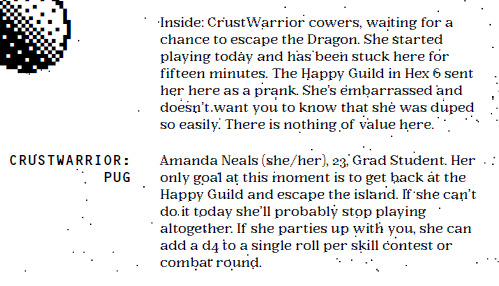
Whenever it leans into the digital world aspects, I'm super into it. Very much my kinda thing. I do wonder though how often players can swap their Roles. I don't believe I've seen that said yet - my inclination would be once on the fly (like Final Fantasy's Job systems).
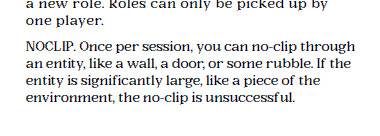
And if these various layers weren't enough, .dungeon also features in-game collectible cards that are sort of enchantments and buffs. I wonder if my real-world level character can spend real money to buy Bytes to buy more packs from a merchant in town? lol
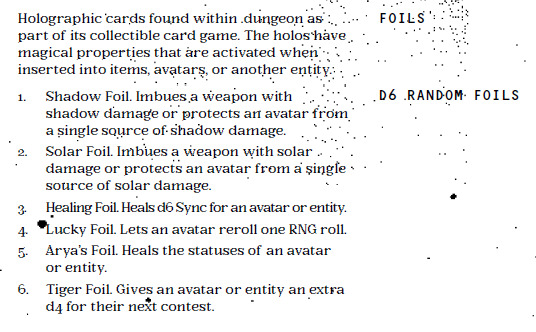
I won't spoil/detail too many more of these but these kind of fun (and common to video games but rarely seen when thinking of the world of a game or the intended way to play) moments are really appealing. Also, this game has Goons in it. Oh no.

Now I'm thinking the intention is the "real-world" level of play should be the real actual you, the person playing .dungeon the TTRPG (as opposed to a real-world level character still within the fiction of the game) since stuff like this would be tricky to track. Cool item!

Tutorial Island is cool, a good blend of char creation, intro to what the game is, and just a fun adventure with a session or more of play to it. I'd have to run/play this to really see but I find the Sync being tied to essentially your real-world session length interesting.

This stuff is cool and leans into that meta/fan-level play that only comes out of these big community-driven games, both MMOs but also things like Dark Souls.

A lot of these kind of possible secrets come as comments in the text, possibly just to inspire the GM and to get players interested in ways that the table can build out on their own over time. So far, I don't see some of the more esoteric secrets to be laid out (which I like).
The rest of the book, as far as I've seen, is lots of resources, gear tables, monsters, etc. to build out the game after player's leave Tutorial Island. The game world here has that anything goes Final Fantasy bent to it. There's swords & wagons, but laser guns & skateboards too.
The setting here is also explicitly queer (mostly seen so far in the "real-world" PUGs) and includes things like sex workers and other elements that it maybe could not have had but that would certainly lessen the richness of its world, the fandom presented throughout, etc.
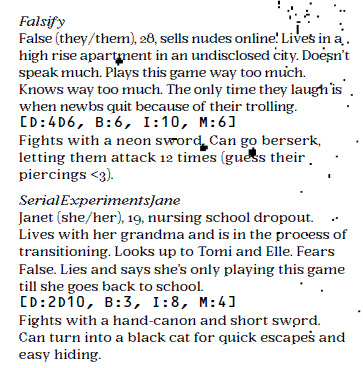
The spellcasting uses the in-game money as mana points essentially. That's a cool way to limit spellcasting and motivate player's, especially spellcasters, to get out there and make some $$$.
Okay, here's the real-world explanation I was waiting for (after the in-game gear lists and such). This is cool - it's fun to have a real-life layer to this and to have the game's world support that sort of dropping in and out, doing things outside of a full party session, etc.
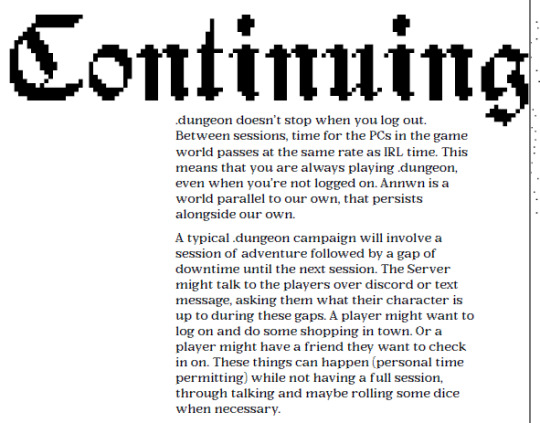
I know a lot of folks do this with ongoing campaigns anyway, but this is one of those fun things to include here to build that in as an expectation in play. You have your raid nights with friends and you have your little solo sessions after work where you sell your loot.
Now, the rest is a nice collection of random dungeon, NPC, settlement, hexfill tables and more. Everything you'd expect from an OSR-like ruleset but occasionally with some fun added meta-layers.
Players getting a quest from an in-game Moderator and then being able to become a Mod themselves is a really fun idea and something I could envision becoming a long-term goal for one or more players at a table. The threat of encountering an Admin is scary as well!

To finish it up, we've got a cool AASCII-style character sheet, complete with MingLiU-ExtB font (my beloved)!
And that's .dungeon//remastered! I really enjoyed reading this, and I think it has a strong core that's really enhanced by its real-world interaction layer. Gonna put this on "Play Soon" list. There are some smart rules in particular I'll likely steal for a future project.
.dungeon//remastered is available digitally NOW with, I believe, physical copies coming soon. I backed the Kickstarter to get this digital version. CHECK IT OUT HERE!
177 notes
·
View notes
Text
Daily update post:
This is Yonatan Shimriz. He's the brother of Alon, one of the 3 Israeli hostages kidnapped by Hamas, and accidentally killed by the IDF due to mistakenly thinking they're terrorists. Yonatan also survived with his family the massacre of Oct 7. And he just had a baby boy. Life WILL win, despite those who think they have the right to take it away.

It's been announced today that Israel has hired Prof. Malcolm Shaw, a Jewish British law professor, who specializes in the field of human rights and territorial disputes, to represent it at the International Court of Justice in the Hague. He's one of 4 lawyers that will represent Israel.

If I hadn't verified this is true through several news sources, I would not have believed this scenario. Terrorists fired an RPG at an IDF helicopter in Gaza, missed it, and ended up hitting a medical clinic in kibbutz Nirim, inside Israel, though as you might imagine, it's very close to the border. This is what the clinic looks like after the hit:

Lebanon has filed a complaint with the UN Security Council, blaming Israel for killing Saleh al-Arouri on its territory. Because harboring a senior Hamas terrorist, responsible for the murders of countless Israeli civilians, is not an issue, apparently. Lebanon charges that this is the biggest escalation between it and Israel since 2006 (the Second Lebanon War). They have no issue with Lebanon violating UN resolution 1701, which put an end to that war, conditioned on Hezbollah not being present anywhere between the Litani river and Lebanon's border with Israel (of course Hezbollah has been, and has been firing rockets at Israel from this area). Then again, the UN has done nothing to enforce that part of resolution 1701, so I guess if they don't care, why should the terrorists?

After I posted yesterday that the most likely scenario for who caused the blasts in Iran that killed 84 people is ISIS, the terrorist organization did take responsibility for the terrorist attack. Guess who Iran is still blaming for the attack, and swearing revenge against? The Jewish state. This is what antisemitism looks like. Well. It's one of its many looks.
On a different note, I wanted to see what the American media said about Claudine Gay's resignation, and I was horrified to hear that it's all painted in terms of liberals vs conservatives. Here's the thing, that may be completely true, but I just don't care. Antisemitism is a real issue, and the way the resignation is talked about, it's like the safety of Jewish students is nothing. Antisemitism is just a tool, and sometimes one political camp uses it against its rival, while at other times, that happens in the opposite direction. But it's like Jews are not even a part of the conversation. IDK, maybe it's because I'm an outsider, but the way Jews don't seem to matter even when antisemitism is supposedly finally being discussed, is truly startling. I'm in the middle of an active war zone, and I'm honestly sat here, worried for Jews abroad.
After a lot of work to gather information about their fate, the last 3 Israeli men missing since Oct 7 are now defined as hostages, which brings the total number of those kidnapped to 136, including bodies, and Israelis kidnapped before the massacre (2 living men and 2 bodies). There's one more missing Israeli woman, whose fate is still to be determined. We're 3 months into this nightmare, and there are still so many question marks. Even with those defined as murdered or kidnapped at a certain point, we've seen that sometimes there's new info, which changes what we believe happened to them.
And here's an example for the latter. This is 38 years old Tamir Adar.

Until yesterday, he was believed to be held hostage in Gaza. As new information was gathered, it was determined that he had been murdered on Oct 7. Tamir is the grandson of Holocaust survivor Yafa Adar, who was herself kidnapped, and released in the hostage deal. His body is still being held by the terrorists. Yafa herself was filmed as she was being taken to Gaza, holding her head up, and not crying. In an interview she gave after her release, she said that she refused to cry, because she wanted her family to be proud of her if they saw the footage. She also said that she's still not free, because her grandson is still in Gaza. I can't imagine what Yafa and her family feel after the news about Tamir's fate. May his memory be a blessing.
(for all of my updates and ask replies regarding Israel, click here)
#israel#israeli#israel news#israel under attack#israel under fire#israelunderattack#terrorism#anti terrorism#antisemitism#hamas#antisemitic#antisemites#jews#jew#judaism#jumblr#frumblr#jewish
95 notes
·
View notes
Note
do you have any metafictional ttrpgs? or any ttrpgs about nothing (being about the concept of nothing or literally not having something they're "about")?
Theme: Metafictional TTRPGS / Games About Nothing.
Y’all are really pulling out the stops for these requests, huh? I’m not entirely sure if what I pulled up actually counts as metafiction, or as games about nothing, but I hope you find something close to what you’re looking for here.




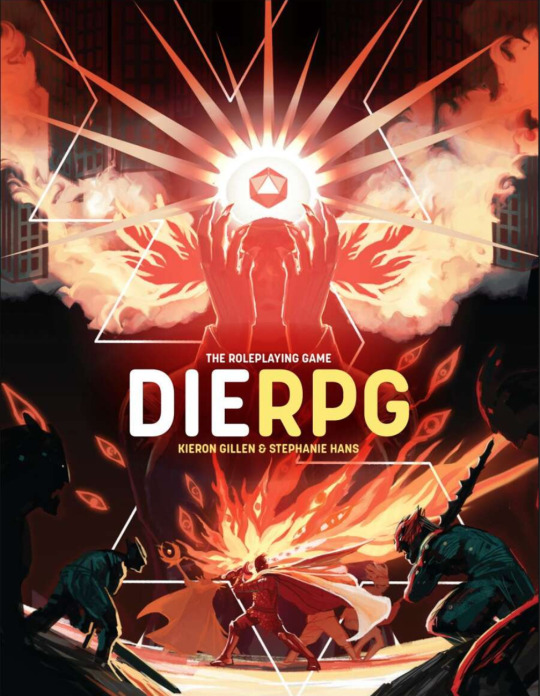
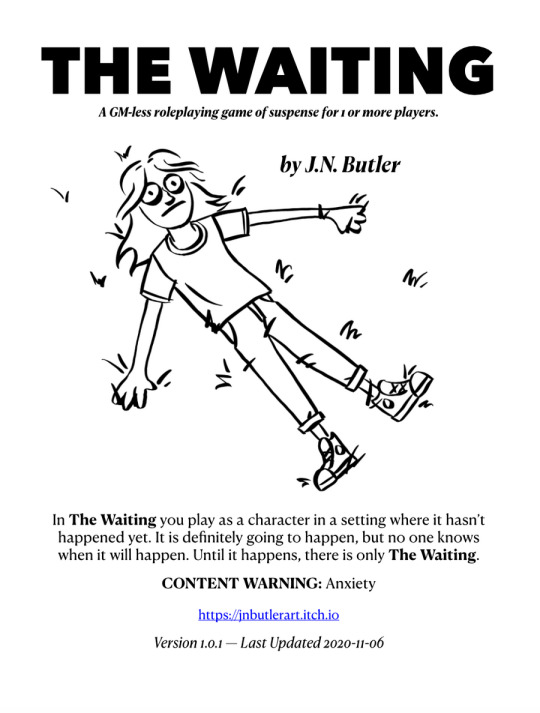
Feedback, by Adira Slattery.
This is a drawing and survey taking game.
You will be expected to draw some chairs.
You will be expected to take some surveys
.Requires the use of a printer for the surveys.
And at the end you gotta email me.
So good luck...
This is a game about drawing a chair. And then taking a survey. And then drawing a chair. And taking a survey. And so on. It’s an exercise that’s meant to be both repetitive and reflective. It’s hard for me to determine what this game is about, because a) I haven’t played it and b) I suspect it’s going to mean something a little different for each person who plays it. It’s possible that for some people who look at this game, it might be about nothing.
Undeath of the Author, by quinntastic.
A meta mini-game designed for Troika.
This is a game in which the author is both dead and not dead - they are undead, and it is up to the group to kill them. The author is the author of the game, and the group is responsible for figuring out how to go about and kill them. (Of course, the author is willing to tell you, the GM how they can be killed, but they don’t want you to tell the players. You can keep a secret, right?)
Beach Episode, by Legendary Vermin.
BEACH EPISODE is a microgame mix-in for your regular table-top RPG group. Players take their current characters, quickly adapt them for a rules-light session, and commence to run an anime-inspired, beach-themed adventure. All you need to play is at least 3d6 and an established set of characters.
This is a game that is about nothing in the sense that it isn’t really about anything. It follows the style of the anime beach episode, asking you to take recognized characters, probably from an ongoing campaign, and giving them a moment of rest, relaxation, and (probably) nothing plot-relevant. It’s great for encouraging players to delve into who their characters are without feeling worried about the consequences.
Meta Society, by Small Stories.
Meta Society is a game about playing a game of Good Society created for the April Fool's Day Good Society game jam.
This is a game about playing a game - specifically a game of Good Society. When you play, you’ll describe fictional players interacting with a fictional setting, using safety tools and talking about what they did and didn’t like about each session. This requires a copy (as well as experienced knowledge) of how to play Good Society, but I think if you have had the experience of playing Good Society, this might also be something you could adapt to make it a metafictional game about playing a different ttrpg.
DIE: The Roleplaying Game, by Rowan, Rook & Decard.
You’re dragged into a treacherous fantasy world made from your own fears, doubts and desires. There’s only one way to escape - but with limitless adventure within your grasp, would you even want to?
In DIE: The Roleplaying Game, you play a group of authentically flawed people from the real world who gather together to play a game and are trapped in a magical realm. What are they prepared to sacrifice to escape? What are they prepared to sacrifice to stay?
This is a TTRPG inspired by a comic book, about people who play games, finding themselves being drawn into a game. Your characters will be interacting with a fantasy world of their own creation, knowing that it is a game and yet being drawn into it deeper than they could have ever imagined. If you want to hear this game in action, My First Dungeon has an excellent season from Mar. 31 - May 26 of 2023.
The Waiting, by J.N. Butler.
A one page GM-less roleplaying game of suspense for 1 or more players.
The Waiting is inspired by the anxiety caused by waiting for the unknown.
In The Waiting you play as a character in a setting where it hasn’t happened yet. It is definitely going to happen, but no one knows when it will happen. Until it happens, there is only The Waiting.
What are you waiting for?
This feels like a game that could be about nothing because the thing that is going to happen will not happen while you play the game. The game is specifically about the time in which the thing has not yet happened - you just know that it will. The game occurs as a series of rounds, over which players describe what their characters are doing. When the event that the table creates happens, you have one final round of play and then the game is over.
This might also be a great tool for dropping into another game, if you’re like me and you like pairing your TTRPGs like cheeses and fine wines.
#tabletop games#indie ttrpgs#game recommendations#dnd#asks#indie ttrpg#metafiction#games about nothing
104 notes
·
View notes
Text


I thought I should probably post about what Open Hearth is. Open Hearth is an online gaming community focused on indie RPGs, storygames, and other TTRPGs—with a commitment to safety and inclusivity. I’m edige23 and I manage this channel for our community (that’s why there’s a lot of my stuff here).
To be a little more specific, Open Hearth Gaming Community is dedicated to supporting TTRPG players and event facilitators. We have a dedicated calendar app which we use to organize events from one-shots to series spanning months.
You can see our website here.
We have a ton of free resources for online play, including character keepers you can use.
We have a Community Code of Conduct (which you’re welcome to use and modify)
This is supported by a Patreon. Folks at the $4+ level have a 48-hour priority sign-up window from when events are posted. After that, anyone is welcome to sign up for sessions. Some sessions are run specifically for new players and waive that window. Full sessions have waitlists, and folks who sign up for those often end up in games.
You can check out our community gaming calendar at Playabl
All sessions are run using a layered set of safety tools and adhere to our community code of conduct.
We have a dedicated Slack for discussing and planning events on the calendar. Anyone who plays in a session with us or supports our Patreon is welcome to join.
We also have one of the largest collections of AP ttrpg videos out there, including several ttrpg talks and panels.
There’s a lot more to what we do: we offer free gaming weekends to introduce folks to online play and new games; we have free game facilitator camps; we have regular talks and seminars on gaming; and we’re working on a relaunch of our podcast. These are all freely available to everyone and made possible by the generous support of our patrons.
If you have questions, feel free to contact us at [email protected]
115 notes
·
View notes
Note
Hey hey!
You may not be the correct person to ask but im gonna ask anyway and if you feel it would be better answered by someone else plz let me know.
So ive been GMing 5e games for a bit and want to branch out into games which arent as unfriendly to the DM in terms of whats required as 5e is.
Im interested in running Knave, but none of my rpg friends seem really interested.
Where do you think a good place online would be to look for new players? Im trans so im a little scared of running games with non lgbt players at the moment...
Heya!
As we discussed in DMs, I'm going to answer this publicly so other people who may be better equipped to answer this question might see it, because I feel woefully unprepared to answer it. So by answering it publicly I'm exposing your ask to lots of people who may know more than I. :) Having said that, I haven't come out completely empty:
@open-hearth-rpg is a community I've followed for quite a while here on Tumblr, and while I haven't partaken in their games after receiving this ask I was immediately reminded of them, because while not an exclusively LGBTQ+ community theirs is a very inclusive community that has lots of safety tools in place to ensure all players' comfort and safety. They specifically act as a sort of a community hub for running games and recruiting players, so if nothing else by putting out the feelers there, I'm sure you'll be able to find like-minded folks. :)
Second suggestion, and this is literally me scrambling for help from the side of the community that knows more about these things than I do, is that lots of RPG creatives of various shades of the LGBTQ+ rainbow have their own communities, and they usually have a dedicated space within those communities for looking for players. Like, unsurprisingly, lots of RPG creatives expect their fans to also play RPGs, so their communities will usually have spaces for organizing games. @threeheartscast has one such community on Discord (it's an unofficial, fan-run one, but since Three of Hearts is a queernormative podcast their community is unsurprisingly also mostly LGBTQ+, I'm also there lurking hi!). I don't mean that you should join the community of an actual play podcast you may not even know about, but if you already know of LGBTQ+ creatives in the hobby space, look around and check out their communities. :)
Anyway if any of my followers want to chime in, please do! There's only so much a clueless guy like me can do to help with this question.
44 notes
·
View notes
Text
kickstarter
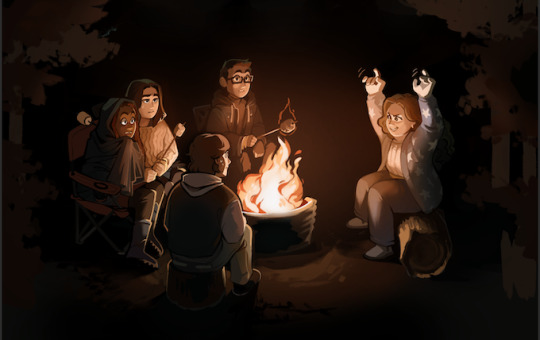


Cryptid Creeks is a tabletop roleplaying game using the popular Powered by the Apocalypse engine and is 'Carved from Brindlewood', a term for content based on Jason Cordova’s award-winning Brindlewood Bay. In this supernatural mystery, you'll play river scouts, a crew of young adults setting out to stop a rapidly spreading curse with the help of ancient cryptids of your own invention.
Creeks has many inspirations including Gravity Falls, Hilda, The Goonies, Lumberjanes and Night in the Woods, representing a genre we feel is surprisingly lacking in RPGs. Through this game, we hope to see themes such as friendship, discovery and community explored by gaming groups and summer campers of all ages and backgrounds.


Cryptid Creeks will feature 150+ pages filled with the beautiful full-colour art you have come to expect from Hatchlings Games. Content will include robust safety tools, character creation, intuitive dice mechanics, a guide to running the game as Navigator, a collection of sample curses, and an appendix of rolling tables and handouts.
The standard edition hardcover can be carried easily and will feature smyth-sewn bindings, a matte laminated cover for durability and recycled paper throughout. The special edition will feature an alternate cover with foil-stamping to make it shimmer, a ribbon bookmark in a spooky shade and an additional chapter with designer notes and concept art.
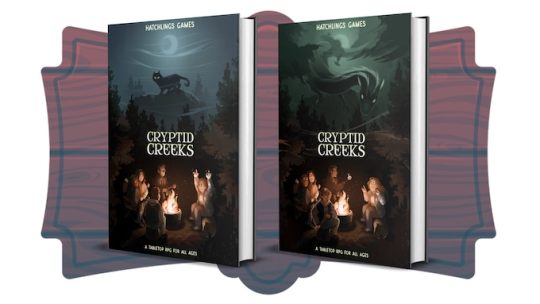

The game begins with the town you call home becoming cursed. This malediction has occurred many times throughout history, most recently in the Autumn of 1962. The nature of the curse is completely down to you, however it always springs from an object sold by the Peddler, an enigmatic demon with hidden motivations. The curse is of particular concern to the Watcher, a benevolent cryptid who has existed in harmony with the townsfolk for centuries. Your crew of scouts must stop the curse before it overwhelms the community and spreads to the neighbouring city.



Your scouts must investigate for Clues to the accursed object while trying to prevent the darkness from spreading! These dual tasks will form the basis of your roleplaying sessions (episodes). The game is best played over several episodes (series), but we have provided rules for one-shot play (pilots).

Once the Watcher visits your clubhouse to inform you of the curse, you'll begin to discover Eeries around your hometown. These minor cryptids act as the eyes and ears of the Watcher and will observe your crew as they travel Clawfoot Creek attempting to find the object. The Eeries are a neutral - sometimes chaotic - presence in the game, but will intervene under special circumstances.
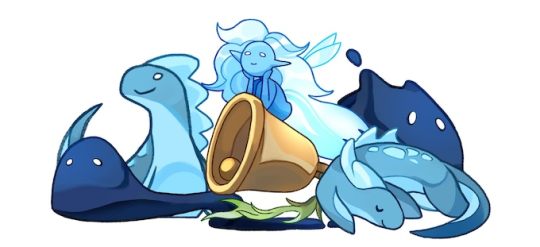

As episodes play out, the curse will spread and grow in strength, its potency measured on a Curse Clock ticking slowly through four phases towards calamity. Your actions during episodes will earn you Clues, and when you believe you've collected enough, you can attempt to destroy the cursed object forever!

Before episodes conclude, you'll be shown a list of milestones that, if met, will reward the crew with Cryptid Keys. These mythical items can be spent to upgrade your clubhouse and boat, factors essential to your progress in the game.


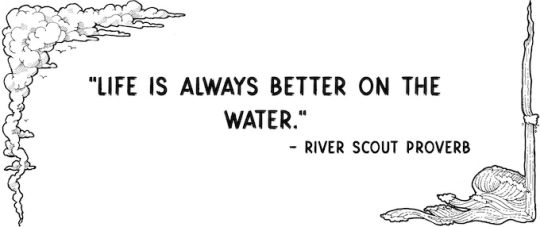
In Creeks, you'll create scouts using playbooks. These templates are provided to ensure character diversity and are ideal for those new to RPGs. Playbooks are named after boating roles, with Skipper, Shipwright, Lookout, Stowaway, Journaller, Negotiator, Medic and Conduit to choose from. The final game will include rules for you to create your own playbooks and select from a pool of special moves we've called Badges.
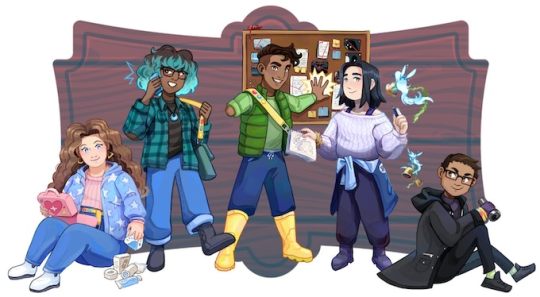

In most Powered by the Apocalypse RPGs, moves are used to determine your actions. In Creeks we have basic moves, which can be used at will, such as The Crew Move (used to clear misfortunes) and The Eerie Move (used to gain support from cryptids). Each playbook also has Badges, which can influence a wide range of mechanics.

The game uses two six-sided dice (2d6) where every roll progresses your story regardless of the outcome. Only players roll dice during sessions, so it never feels like a competition with the Navigator. Instead, they'll be your biggest fan, willing you to succeed as they represent the characters you'll meet and the challenges you'll face.
If your rolls fail (6 or below), the Navigator has an opportunity to react. They might drop misfortunes on your scouts to slow your actions, split the party so you can't rely on one another, or even progress the Curse Clock!
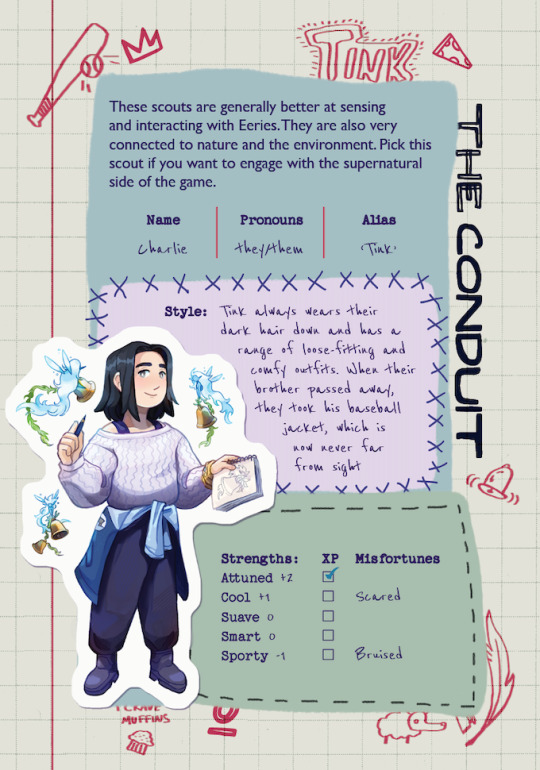


To stop the curse, you'll travel Clawfoot Creek visiting landmarks and inspiring locals to fight alongside you. To achieve this, you'll need a boat. Name your trusty vessel, then upgrade it to reach new locations on the map or welcome Eeries aboard, like the treasure-hunting Goldtooth. We're encouraging Navigators to incorporate creeks, coves and beaches into their adventures to ensure players use their boat often.


Having worked for a Deaf charity for twelve years and raising a disabled child, making Cryptid Creeks accessible to everyone is really important to us. To honour this commitment, we have hired Chris Hopper, one of the most experienced consultants in the industry with credits including Tal'Dorei Reborn from Critical Role and most recently Tales of the Valiant from Kobold Press.
The digital PDFs will accommodate screen-readers and feature alt text and chapter hyperlinks as well as plain text versions. Both hardcovers will have colour-coded page edges for intuitive navigation. Our website will also host form-fillable handouts for both players and Navigators.

Kickstarter campaign ends: Thu, October 5 2023 2:59 PM BST
Website: [Hatchlings Games] [facebook] [twitter] [instagram]
60 notes
·
View notes
Text
QSMP Safety Tools for Players
A lot of players on the QSMP have stated their frustration and discouragement with the recent purgatory event, and while there is a universal agreement to not witch hunt or pit communities against people. It doesn't invalidate their feelings when issues are overlooked.
This is by no means a call to action to harass a person.
But maybe this could be a healthy exercise in putting that energy we feel as their audience into something that could contribute in the overall health and success of the QSMP player community.
Who would think that rp-ing for 8 hours straight on the daily would be emotionally exhausting?
So please use this post to put up ideas for safety tools* or safety tools from other systems (please source them) that would benefit an SMP as oppose to the traditional environment of a table top RPG.
*Safety Tools are used in table top role playing games (like D&D) by the Game Master (GM) to protect players from themes that would make the game less fun for them. Its not a tool to censor or railroad the story, rather to keep the game fun for everyone. Whether a theme is uncomfortable or triggering, safety tools are in place to find out each players boundaries and help everyone respect them in game.
For example X-card is a tool created by John Stavropoulos as an easy way for players to communicate with the GM if a scene is uncomfortable for them they would touch or place forth a card with an "x" on it, in which case the GM would change or skip over the scene no questions asked.
This wouldn't work quite as well within an SMP due to the lack of GM to kind of lead the scene out, if players are to into their characters to stop. But that is the general gist of it. If you're interested in this topic feel free to google them as there are so many safety tools out there.
High-Viz Leather chest plate.
An orange leather chest plate that players can wear to signify that they are out of role play for whatever reason. Players with it on can still play and build, but are not interested in the rp angst of the moment, and are immune to PVP combat unless consented to. Basically a visual indication that would allow players to play and interact with others without the paranoia of threat due to the voice group making it hard for first contact to occur without death.
Warped Fungus Door.
A play on Kimi Hughes, Exit the scene. Players are given a warped fungus door that they can use to exit a scene by placing it and walking through it. They aren't oppose to the contents of the scene but are no longer comfortable in participating in it. There is no consequence or penalty for it, but a player cannot reenter the scene until it is done. So as not to have players use it as an advantage in game, such as PVP.
#qsmp#qsmp purgatory#team bolas#team green ninja#team soulfire#philza#tubbo#baghera jones#fitmc#missasinfonia#vegetta777#foolish gamers#agentemaxo#jaiden animations#slimecicle#badboyhalo#roier#rubius#el mariana#quackity#cellbit#forever player#tazercraft#etoiles#kameto#antoine daniel#aypierre#nihachu#riversgg#ironmouse
51 notes
·
View notes
Text
The Department
The Department Susan Cathleen Powell, 2019
-----
Sabrina Hawthorne is a fellow enthusiast of rare RPGs. She's the one who actually found a write-up of The Revolution by a GM for a table of players who didn't want to read the whole thing. We originally met at a mini-golf course, of all places (fuck you, windmill), and ended up chatting about mechanics in card-based games. When she told me about this one I knew it was a perfect fit for the blog and invited her to write a guest post. Here it is!
----
You know the SCP wiki? You know those articles that dive super far into the deep history, where characters straight out of the Hebrew Bible use arcane orbital lasers to wage a planet-wide war on mutant flesh monsters, and bigfoot is there too?
The Department is one of those, in the form of a hack for The Quiet Year.
You play as the board of directors for the titular Department, who are the SCP foundation in all but name. Your researchers have come across an anomalous archaeological dig site, and it’s your job to guide the organization to learn as much as they can about it – and the secret world history it’s a part of - before it’s destroyed by the vague sleeping horror that you disturbed when the site broke ground.
For the most part, the game runs the same as The Quiet Year, but with spookier and more bureaucratic flavor text. There’s a phase at the end of each round called a Board Meeting that’s a bare bones hidden role board game that doesn’t really feel as scheme-y or capitalistic as it wants to, but other than that it runs smoothly.
The real life of the party is the Countdown mechanic. Whenever a player draws an Ace of any suit from the deck, the Countdown advances, causing more strange occurrences and anomalous dangers to crop up around the dig site. When the last Ace is drawn, the game ends, and players are strictly forbidden to tie up any loose ends that their improvised story left hanging. And since in this one you pull from a combined deck of 52, those aces can come randomly at any time.
There isn’t any art in The Department, which makes sense. It’s 12 pages, and it’s only that long because of a very thorough section on consent and safety tools. Nonetheless, it’s packed with exactly the kind of style that this game needs. The front and back covers look like a manila folder, and the whole thing looks like a partially declassified government document.
Susan Powell apparently sold a few of her games through her onlyfans page, alongside more of what you might expect of an onlyfans page. I got my copy from a friend though, and I haven’t been able to track Susan down anywhere on the internet.
#ttrpg#imaginary#indie ttrpg#rpg#review#unreality#scp#guest post#fuck you windmill#not the first time SCP has shown up on this blog and i'm sure it won't be the last
16 notes
·
View notes
Text
The Game Ib and Mary-ism, a Materialist Analysis.
AT first glance, the game Ib's 3 central characters seem to have nothing to do with a materialist understanding of the world. They seem more like Platonic idealized forms, character archetypes more than real people. However, as with analysis of any creative work, the material relevance of such a work is always found in the correspondence of such archetypes to the world we live.
Ib, the nine year old girl representing the player, is the human embodiment of the player's choices. As is typical for the RPG horror genre, she doesn't talk except to advance the plot. Ib enters the abyssal gallery voluntarily, gets stuck, and although silent, is clearly entranced by the gallery's otherworldly sights and clearly afraid of the gallery's horrors and wants to go home. Thus, Ib is the audience of the game at large, us who are expected to experience the drama between these two people and undergo a potential change in opinion.
Garry, the male character that Ib meets first, is initially presented as someone just like Ib: an outsider to Guertena's gallery of horrors who stumbled into the art gallery by another entrance. Immediately, however, Ib sees that Garry is not like her. He is an adult, he is visibly shaken by the gallery, and he thinks nothing of the rules of the gallery. Despite needing to be rescued by Ib, he is paternalistic towards her and refuses to see her as an equal (despite both being held prisoner in an abyssal nightmare world). When he does help Ib, he never asks for her feelings and retains his aloof, cold personality, always attempting to maintain the illusion of dominance and control over the unpredictable situation. When the gallery tries to stop their attempt at escape, Garry violently destroys the obstacles in his way, paying no heed to the fact that the entire gallery, all of the paintings and sculptures, and all of the dolls are sentient. In Garry, we see man as socialized under capitalism: selfish, incapable of true compassion, and a sense of manhood based on control over the environment, women, and children.
Mary, the female character that Ib meets next, is a vivacious girl. She is carefree, scatterbrained, and friendly. In short, the perfect picture of youthful innocence, the girl who just wants a friend. However, despite her cheerful appearance, we soon learn of an unsettling secret. The sentient gallery, in trying to split up the trio, informs Garry (and the player, but not Ib in-game) that Mary is not human, but merely a painting. Up until now, Guertena's paintings have only been threats to the safety of Garry and Ib, Garry instantly dehumanizes Mary and treats her as an enemy. When the gallery then informs Mary of this, she has a mental breakdown, repeatedly stabbing the head of a statue. We learn very quickly that Mary is crazy and is not above murdering Garry to escape the gallery and finally live a life of dignity, of friends, of sunshine, and not of the endless depression and monotony of the gallery. In some endings, she even murders Ib (despite being friends) simply to protect her secret because after Garry's betrayal she no longer trusts anyone else to understand and accept her. In Mary, we see humanity's atomized state under capitalism: completely isolated, lonely, friendless, a product of a depressing and hostile environment. Any "help" from society comes only from patronizing Garries who do not respect their human dignity but help others only to help themselves. Thus, self-identified Marries are simply tools to Garries, to be outcast when they violate the bourgeois sensibilities of "normality". Each call of friendship (as represented by Ib) is potentially a beckon to freedom, but also potentially a stab in the back. Such people both long for a true friend, but also fear the worst. This causes insanity, as manifest in Mary's uncontrolled violence, or a surrender to darkness, as manifest in Mary's worst ending (where the darkness engulfs her and destroys what is left of her pure soul).
And yet, it is impossible to blame Mary for her actions. After all, her murder of Garry (or Ib) was manipulated by the gallery itself, and her insanity is simply a product of her lengthy solitary confinement in the abyssal gallery of Guertena. Her happy personality can only be sustained by the creation of her own coping space, a bright, colorful, hand-drawn world created by a child where everything is at peace and there is no violence. As a result of her active resistance to the dehumanizing environment around her, Mary is in fact more human than Garry. It is Mary who protects her own rose (compared to Garry or Ib), despite the fact her life force is not bound in her rose like that of the two humans from the outside. It is Mary, not Garry, who accepts those different than herself and tries to make friends (despite the fact such people could kill her). It is Mary who believes the gallery can be escaped, despite growing up there and having never seen the outside world, and Garry who before meeting Ib, lost hope, despite having come not long ago from the outside world.
However, no amount of time in this personal space can deny her reality: she is still a painting and is bound by the dehumanizing rules of a sentient, unified, and malicious gallery. As Ib and Garry find, it actively blocks their escape routes, manipulates pictures motivated by greed to kill them, and when it seems like Garry, Ib, and Mary might all make it out alive united as friends, the gallery actively conspires against them, first splitting them up by force and then manipulating Garry's arrogance and Mary's fear to force Ib to choose (the murder of) one of her friends. In short, the gallery is a metaphor for modern capitalism: an all-encompassing system of inhumanity that defends itself by actively blocking (often with lethal force) those who stand up to it, and will get you to treat potential friends as enemies. If not opposed, capitalism creates a personal hell for each person where insanity or murder (or suicide) become preferable to the depressing alternative, and worst of all, it will turn your coping mechanism into a crutch and its preservation into the motive for attacking others. However, such a crutch at least shows the inkling of mental resistance, and thus, allows a modicum of humanity (even in the insane) not present in those who have already surrendered to capitalism.
Of course, as materialists, we must recognize the failing of any RPG. By focusing on the exploits of a main character in making key plot choices, RPGs necessarily advance an idealist, great-man theory view of events. The escape from the real world abyssal gallery of capitalism is not decided by real world Ibs, who are somehow born fearless and mentally whole, but by the collective action of the proletariat, led by the vanguard party. However, Ib teaches us that personal class affiliation is not enough, we must always strive to unify as great a section of the revolutionary classes as possible (trying to be friends with both Garry and Mary) but if the capitalist system impels us (as the gallery did between Garry and Mary), we are to preferentially uplift the most exploited (the working class, in all of our hues, genders, and cognitive abilities). We, the exploited masses, are all Marries before the capitalist class. In our self-liberation, we must become fearless and constantly alert like Ib. In real life, we are not rescued by Ib, we rescue ourselves by becoming Ib.
-- me (mary4) and metalpegasus
Symbols:
Yellow roses are a new revolutionary symbol.
It represents the mentally ill who had their minds shattered by capitalism and it's dehumanizing conditioning.
It represents the Marries.
me and you
Blue roses represent the Garries.
Whose who conform to capitalism's dehumanizing conditioning.
Red roses Represent the Ibs.
The liberators.
Who we should strive to be.
References:

#mary (ib)#mary#ib#garry (ib)#ib game#misao#yume nikki#mad father#garry#communism#marxism leninism#marxism#socialism#karl marx#alienation#cute!#capitalsim sucks#marysim#spoilers#spoiler alert#spoliers
9 notes
·
View notes
Text
Now at IPR: Splat 4: Frights

By @summoningcirclepress!
Splat 4: Frights is a zine focused on how to safely and meaningfully play with horror in RPGs. It includes eight eerily-informative essays about the monstrous and the human, history and ritual, as well as safety and design.
What's Inside
Casper (@casperolivervo) is writing about why queer folks tend to gravitate towards horror and see themselves in the genre.
CJ (@scholasticdragn) is writing about how to play safely within horror and how to explore horrific themes meaningfully.
Jay (@jdragsky) is writing about Bloody Mary, Beetlejuice, and the Lindworm: what it means when your game is haunted by ghosts.
Josephine (@scarydogfriend) is writing about the racial and sociological implications of monsters and a few examples of how to write non-racist monster stories, whether it's fighting or kissing them.
Noordin Ali (@werewolffeels) is writing about skipping the surprises, and playing with informed and enthusiastic consent in horror. Warn your players what's coming, but keep the tension high!
Rue (@ilananight) is writing about bringing elements of atmosphere, storytelling, and mechanics from horror video games to the table, translating digital horror to analog.
Sadia (@sadiabies) is writing about the relationship between horror and desire, and how to use players’ taboo appetites to engage them in horror games.
Seb (@goodluckpress) is writing about creating your own safety tools for horror games to maintain tension and atmosphere, while still prioritizing safety during play.
https://www.indiepressrevolution.com/xcart/Splat-4-Frights-Print-PDF.html
22 notes
·
View notes
Text
Our first episode of 10 Candles is out! Come experience the horrors with us as we talk through mechanics, discuss rpg safety tools, and prepare for the end.
Heads-up ahead of time, folks: part of the central premise of this game is that we start with the knowledge that all characters will die. While this is our setup episode and does not contain gameplay, if tragedy isn't your jam, maybe skip this arc.
7 notes
·
View notes
Text

Mermay 2024 - 4 - 'Raid'
Beneath the waves of the Mor Bras, the Great Sea that surrounds the Armorican Peninsula, there is a city lost to time. Ker-Ys was once the jewel of a great kingdom, a beacon of prosperity and magic. But dark forces worked against the city and it was destroyed in a powerful magical storm, its princess condemned to live alone as a mermaid in her ruined home. But Ahes was resilient and clever, discovering that, while she could never again be human, she could make other Marie-Morgane. Taking in the lost and outcast of Alvez, Ys-Beneath-the-Waves rises again.
---------------------------
Val's Notes: It really was not my intention to make more complex scenes for this set, but between Renee and Ailinor and this one featuring Dominique the Ranger and Aisha the Paladin, I am pretty happy with the results and may try to do a few similar ones for the rest of the set.
In this scene, our brave heroines have left the relative safety of the Three Hills to patrol the Lower Wards, the deepest part of Ys-Beneath-the-Waves, where Ahes light does not reach. These rangers are charged with clearing out the ruins of dangerous creatures like the feral, cannibalistic Finfolk, who regularly attack the Marie-Morgane, making the city safer for the daughters of Ys. Life in the Lower Wards and within the Seawall is dangerous even for experienced adventurers like Aisha and Dominique.
Aisha is wielding an espadon, the polearm favoured by the Beg-Sabrenn, the martial elite of the Marie-Morgane. The glowing orb in the foreground is Tan-Mor, a type of seaweed infused with the magical power of passing storms that glows when exposed to certain elements.
---------------------------
Back in 2019, I launched a special series for Mermay, an art project to develop a small, but important part of the lore of Alvez, the world of Kroashent. The Marie-Morgane of Ys-Beneath-the-Waves are one of several merfolk races of the world. For this project, I decided to "adapt" each of the Dungeons and Dragons Character Classes into a character as they may appear in Alvez, then transform these characters into mermaids with art and short stories! Since then, I've been working hard on developing the world and the characters who live, there, even writing an ongoing novella, Kroashent: Bal des Loups, which you can read right now, for free!
---------------------------
Planning on revisiting Ys-Beneath-the-Waves once more this Mermay and checking in on all the Marie-Morgane. I am currently looking for prompts to help inspire this set, so suggestions are welcome if you have ideas for the other girls!
First of 2024 - Ahes
https://www.tumblr.com/kroashent/749315089989091328/mermay-2024-1-welcome-back?source=share
Previous: Love and Peace with Ailinor and Renee
https://www.tumblr.com/kroashent/749671404499238912/mermay-2024-3-love-and-peace?source=share
---------------------------
Want to support Aisha, Dominique and the Kroashent project? Check out my patreon page, for exclusive alternate versions of this drawing and other great rewards! All your support means a lot to me and helps bring the world of Kroashent to life! Check it out here: www.patreon.com/Kroashent
Interested in getting your own idea drawn by me? Commissions are open:
#Aisha Min Iram#Dominique the Ranger#Paladin#Kroashent#Marie-Morgane#mermay 2024#mermay#mermaychallenge#mermaid#fantasy#fantasy art#artists on tumblr#fantasy character
4 notes
·
View notes